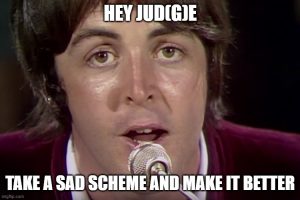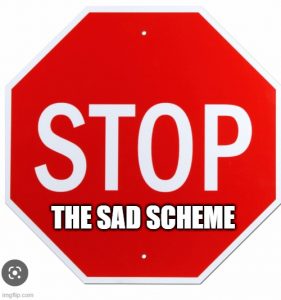N.D. Cal. Judge Pushes Back on Copyright SAD Scheme Cases–Viral DRM v. YouTube Schedule A Defendants
My SAD Scheme paper provided some data indicating that 88% of SAD Scheme cases involved trademarks, with only 6% each in copyright and patents. So SAD Scheme copyright cases aren’t unheard of, but they are rare.
* * *
A copyright owner, Viral DRM, brought SAD Scheme cases against YouTube uploaders in the Northern District of California (not the more typical N.D. Ill. venue). “Plaintiff alleges Defendants downloaded and copied Plaintiff’s copyrighted materials from YouTube, and then re-uploaded infringing versions of Plaintiff’s copyrighted media content to their YouTube channels.” Viral DRM sued 20 defendants enumerated in a Schedule A and got an ex parte TRO. In a plot twist, the court denies Viral DRM’s preliminary injunction request and orders Viral DRM to explain its bases for jurisdiction and joinder or else the case will fall apart.
Jurisdiction. Four defendants submitted 512(g) counternotifications and thus agreed to jurisdiction in YouTube’s home court (N.D. Cal.). That leaves open the jurisdictional basis for the other 16 defendants.
Viral DRM argued:
Defendants committed the following intentional acts expressly aimed at California: (1) downloading Viral DRM’s works from YouTube, Instagram, Facebook, or Twitter; (2) removing Viral DRM’s copyright management information from Plaintiff’s videos; and (3) uploading infringing works to YouTube
These kinds of generic arguments might fly in N.D. Ill, but not N.D. Cal. The court says that uploading videos to YouTube doesn’t create jurisdiction in YouTube’s home court. Without jurisdiction, the court vacates the TRO for the 16 defendants.
Joinder. The court rejects a standard joinder argument used by SAD Scheme plaintiffs:
Plaintiff does not allege each defendant is jointly, severally, or in the alternative liable for the infringement of another defendant arising out of the same transaction, occurrence, or series of transactions or occurrences. And it does not appear that it could do so as Schedule A to the Complaint alleges the Defendants have different websites and different names, and Mr. Rollins’ declaration in support of the TRO indicates Defendants are from different countries. There are no allegations suggesting the claims against each separate Defendant arise out of the same transaction or occurrence; rather, they allege separate acts of copyright infringement.
Implications
The court concludes that the defendants without jurisdiction or misjoined will be dismissed. Odds are high that Viral DRM will abandon the case or whittle it down to one or just a handful of defendants.
 This is a good outcome, but I’m once again troubled by how we got here. The jurisdictional and joinder defects were apparent from the complaint. In other words, the court could have–AND SHOULD HAVE–called out these issues during the ex parte TRO hearing. If the court had done so, the court would not have granted the ex parte TRO against most/all of the defendants. Instead, Viral DRM got an ex parte TRO it never deserved. The judge doesn’t issue a mea culpa for her avoidable mistake or excoriate Viral DRM for getting an undeserved TRO. I reiterate my view that ex parte hearings are notoriously error-prone and should be viewed as an extreme option.
This is a good outcome, but I’m once again troubled by how we got here. The jurisdictional and joinder defects were apparent from the complaint. In other words, the court could have–AND SHOULD HAVE–called out these issues during the ex parte TRO hearing. If the court had done so, the court would not have granted the ex parte TRO against most/all of the defendants. Instead, Viral DRM got an ex parte TRO it never deserved. The judge doesn’t issue a mea culpa for her avoidable mistake or excoriate Viral DRM for getting an undeserved TRO. I reiterate my view that ex parte hearings are notoriously error-prone and should be viewed as an extreme option.
 Worse, even if the court fixed the problem at the preliminary injunction stage, SAD Scheme plaintiffs typically do much of their damage using the ex parte TROs (though it’s not clear from the court’s opinion if that happened in this case). Accordingly, the court’s erroneous issuance of the TRO had dangerous real world consequences. For this and many other reasons, I reiterate: #StopTheSADScheme.
Worse, even if the court fixed the problem at the preliminary injunction stage, SAD Scheme plaintiffs typically do much of their damage using the ex parte TROs (though it’s not clear from the court’s opinion if that happened in this case). Accordingly, the court’s erroneous issuance of the TRO had dangerous real world consequences. For this and many other reasons, I reiterate: #StopTheSADScheme.
Case Citation: Viral DRM LLC v. YouTube Uploaders Listed on Schedule A, 2024 WL 189013 (N.D. Cal. Jan. 17, 2024)
* * *
Bonus 1: The court issued a related ruling, Viral DRM LLC v. Onyshchuk, 2024 WL 189011 (N.D. Cal. Jan. 17, 2024). The CourtListener page. Similar to the case above, the court denies default judgment against 8 defendants (3 of whom had counternoticed) because of jurisdictional and joinder concerns.
* * *
Bonus 2: Tang v. Schedule A Defendants, 1:23-cv-04587 (N.D. Ill. Jan. 4, 2024). This is a design patent SAD Scheme case. Patents (whether utility or design) are ill-suited for the SAD Scheme because the AIA Invents Act raised the bar on joinder in ways that conflict with the SAD Scheme. Despite that, as we saw above, courts may not adequately superintend patent joinder standards at the ex parte TRO stage. In this case, defendants actually appear in court and–surprise!–the court recognized that the rightsowner overreached, but only after hearing from the other side.
As evidence of the defendants’ relationships with each other, the rightsowner argued that the online storefronts share numerous similarities. The court says:
Insofar as the defendants use the same words and images, they are generally descriptive of the function of the shelves being sold (e.g., images of irons on the selves, use of “ironing board hanger”), and the prices range significantly….Even if the webpages were identical, it would not necessarily suggest the defendants are connected. To the contrary, it would hardly be surprising that multiple, independent sellers of similar products would parrot each other’s webpages or match each other’s prices.
The court summarizes:
Essentially, Plaintiff’s complaint boils down to a claim that the defendants infringed on his design patent in the same way. That is not sufficient to link one defendant’s infringement to another as part of “the same transaction, occurrence, or series of transactions or occurrences.”
Thus, the moving defendants get dismissed from the case due to misjoinder.
The court is correct that parallel independent marketplace infringements don’t support joinder, just as the Viral DRM court also held. Yet, the opinion takes a sour turn when the judge tries to explain why the joinder analysis might be different with trademark cases. In a prior opinion:
The Court described how a “swarm” of counterfeiters attacking Bose’s trademarks fit the bill, contrasting this game of “whack-a-mole” with the analogy offered in AF Holdings: individuals who play at the same blackjack table, with the same strategy and maybe even the same dealer and winnings, at different times. The “swarm” was the occurrence from which Bose sought shelter, not any one act of counterfeiting.
“Shelter from the swarm” might resemble a Dylan-esque lyric, but it’s terrible jurisprudence. How exactly does the alleged “swarm” differ from the parallel independent infringements that the Viral DRM court and this court (in the design patent context) rejected? I think that the “counterfeiter swarm” construct instead is a judicial fiction that improperly ignores the plain text of joinder rules. This is one of many maddening corner-cuts that plague the N.D. Ill. SAD Scheme jurisprudence–and contribute to significant victimization of SAD Scheme defendants.
* * *
Prior Blog Posts on the SAD Scheme
- A Judge Enumerates a SAD Scheme Plaintiff’s Multiple Abuses, But Still Won’t Award Sanctions–Jiangsu Huari Webbing Leather v. Schedule A Defendants
- Why Online Marketplaces Don’t Do More to Combat the SAD Scheme–Squishmallows v. Alibaba
- SAD Scheme Cases Are Always Troubling–Betty’s Best v. Schedule A Defendants
- Judge Pushes Back on SAD Scheme Sealing Requests
- Roblox Sanctioned for SAD Scheme Abuse–Roblox v. Schedule A Defendants
- Now Available: the Published Version of My SAD Scheme Article
- In a SAD Scheme Case, Court Rejects Injunction Over “Emoji” Trademark
- Schedule A (SAD Scheme) Plaintiff Sanctioned for “Fraud on the Court”–Xped v. Respect the Look
- My Comments to the USPTO About the SAD Scheme and Anticounterfeiting/Antipiracy Efforts
- My New Article on Abusive “Schedule A” IP Lawsuits Will Likely Leave You Angry
- If the Word “Emoji” is a Protectable Trademark, What Happens Next?–Emoji GmbH v. Schedule A Defendants
- My Declaration Identifying Emoji Co. GmbH as a Possible Trademark Troll

